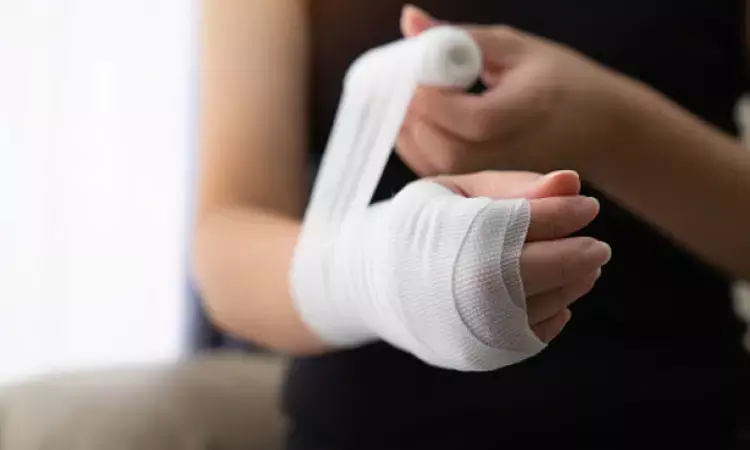- Home
- Medical news & Guidelines
- Anesthesiology
- Cardiology and CTVS
- Critical Care
- Dentistry
- Dermatology
- Diabetes and Endocrinology
- ENT
- Gastroenterology
- Medicine
- Nephrology
- Neurology
- Obstretics-Gynaecology
- Oncology
- Ophthalmology
- Orthopaedics
- Pediatrics-Neonatology
- Psychiatry
- Pulmonology
- Radiology
- Surgery
- Urology
- Laboratory Medicine
- Diet
- Nursing
- Paramedical
- Physiotherapy
- Health news
- Fact Check
- Bone Health Fact Check
- Brain Health Fact Check
- Cancer Related Fact Check
- Child Care Fact Check
- Dental and oral health fact check
- Diabetes and metabolic health fact check
- Diet and Nutrition Fact Check
- Eye and ENT Care Fact Check
- Fitness fact check
- Gut health fact check
- Heart health fact check
- Kidney health fact check
- Medical education fact check
- Men's health fact check
- Respiratory fact check
- Skin and hair care fact check
- Vaccine and Immunization fact check
- Women's health fact check
- AYUSH
- State News
- Andaman and Nicobar Islands
- Andhra Pradesh
- Arunachal Pradesh
- Assam
- Bihar
- Chandigarh
- Chattisgarh
- Dadra and Nagar Haveli
- Daman and Diu
- Delhi
- Goa
- Gujarat
- Haryana
- Himachal Pradesh
- Jammu & Kashmir
- Jharkhand
- Karnataka
- Kerala
- Ladakh
- Lakshadweep
- Madhya Pradesh
- Maharashtra
- Manipur
- Meghalaya
- Mizoram
- Nagaland
- Odisha
- Puducherry
- Punjab
- Rajasthan
- Sikkim
- Tamil Nadu
- Telangana
- Tripura
- Uttar Pradesh
- Uttrakhand
- West Bengal
- Medical Education
- Industry
Torus fracture recovery similar between kids with bandage or immobilization: Lancet

UK: In research, Daniel C. Perry and colleagues discovered no differences between groups in pain or function throughout the course of the 6-week follow-up period in children with a torus fracture of the distal radius. The findings of this study were published in The Lancet.
Children most frequently suffer from wrist torus (buckle) fractures. Treatment is in dispute, and options include anything from splint immobilization and release to cast immobilization, follow-up, and further imaging. In this study, pain and function were evaluated between children who received a light bandage and quick release and those who received strict immobilization and follow-up in accordance with the treatment center protocol.
965 kids (aged 4 to 15) with distal radius torus fractures were included in this randomized controlled equivalency experiment from 23 UK institutions. Using custom web-based randomization tools, children were randomly assigned in a 1:1 ratio to the offer of a bandage group or a rigid immobilization group. Clinicians, participants, and their families were all treated, so treatment allocation could not be concealed. Multiple injuries, diagnosis more than 36 hours after injury, and failure to complete follow-up were exclusion factors. The Wong-Baker FACES Pain Rating Scale was used to assess pain three days after randomization as the main outcome. There was also a modified intention-to-treat and per protocol analysis.
The key findings of this study were as follows:
1. 965 kids were randomly assigned to two groups between January 16, 2019, and July 13, 2020.
2. Of those kids, 489 received the bandage offer, while 476 received rigid immobilization.
3. Of those kids, 379 (or 39%) were females, and 586 (or 61%) were boys.
4. 908 (94%) of the participants had their primary outcome data collected, and every one of them was taken into account in the modified intention-to-treat analysis.
5. In the bandage offer group, the pain score on day three was 3.21, compared to 3.14 in the rigid immobilization group.
6. The corrected difference in the intention-to-treat population was -0.10 and -00.6 in the per-protocol population with reference to a predetermined equivalence margin of 10.
In conclusion, this experiment backs the practice of discharging children with distal radius torus fractures from the emergency room right away and offering them a bandage.
Reference:
Perry, D. C., Achten, J., Knight, R., Appelbe, D., Dutton, S. J., Dritsaki, M., Mason, J. M., Roland, D. T., Messahel, S., Widnall, J., Costa, M. L., Ahmad, R., Cadman, E., … Wood, D. (2022). Immobilisation of torus fractures of the wrist in children (FORCE): a randomised controlled equivalence trial in the UK. In The Lancet (Vol. 400, Issue 10345, pp. 39–47). Elsevier BV. https://doi.org/10.1016/s0140-6736(22)01015-7
Neuroscience Masters graduate
Jacinthlyn Sylvia, a Neuroscience Master's graduate from Chennai has worked extensively in deciphering the neurobiology of cognition and motor control in aging. She also has spread-out exposure to Neurosurgery from her Bachelor’s. She is currently involved in active Neuro-Oncology research. She is an upcoming neuroscientist with a fiery passion for writing. Her news cover at Medical Dialogues feature recent discoveries and updates from the healthcare and biomedical research fields. She can be reached at editorial@medicaldialogues.in
Dr Kamal Kant Kohli-MBBS, DTCD- a chest specialist with more than 30 years of practice and a flair for writing clinical articles, Dr Kamal Kant Kohli joined Medical Dialogues as a Chief Editor of Medical News. Besides writing articles, as an editor, he proofreads and verifies all the medical content published on Medical Dialogues including those coming from journals, studies,medical conferences,guidelines etc. Email: drkohli@medicaldialogues.in. Contact no. 011-43720751


